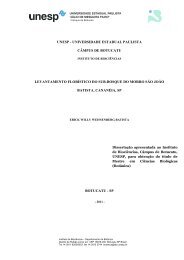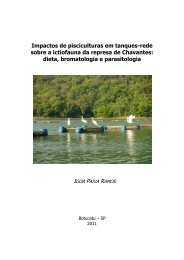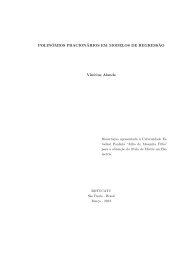Visualizar Tese - Instituto de Biociências - Unesp
Visualizar Tese - Instituto de Biociências - Unesp
Visualizar Tese - Instituto de Biociências - Unesp
Create successful ePaper yourself
Turn your PDF publications into a flip-book with our unique Google optimized e-Paper software.
AbstractAlthough strong evi<strong>de</strong>nce show that the myogenic regulatory factors (MRFs)and insulin-like growth factor (IGF-I) have important roles in the hypertrophy responseafter acute resistance training, it is still unclear if response of MRFs and IGF-I alsooccurs during the adaptation to prolonged periods of resistance training (RT). Therefore,the purpose of this study was to test the hypothesis that fiber-types transition andhypertrophy during long-term RT could be associated with increased MRFs and IGF-ImRNA expression in the skeletal muscle. Male Wistar rats (80 days old, 250-300 g)were divi<strong>de</strong>d into four groups: 8 weeks control (C8, n = 8), 8-weeks trained (T8, n = 8),12-weeks control (C12, n = 8), 12-weeks trained (T12, n = 8). T8 and T12 groups weresubmitted to a progressive RT program (3 day/week) for 8 and 12 weeks, respectively.The training protocol consisted of four sets of 10–12 repetitions, with a 40 s rest periodbetween each set, performed at 65–75% of one repetition maximum (1RM). At the endof the experiment, animals were sacrificed and the plantaris muscle collected formorphological and molecular analysis. The RT did not change (p > 0.05) in bodyweight gain and food intake in the T8 and T12 compared to the C8 and C12 groups,respectively. After 8 and 12 weeks of RT, the absolute (T8: 69.7% vs. T12: 126.0%; p 0.05), MyoD (T8: 22.9% vs. T12: 22.3%; p > 0.05) and muscle fiber crosssectionalarea (CSA) (T8: 29% vs. T12: 35%; p > 0.05) in the T8 and T12, compared toC8 and C12 groups, respectively. After 8 weeks of RT, IGF-I increased in 30.1% in theT8 compared to C8 group, but returned to baseline after 12 weeks of RT. Themodulation of MHCIIx/d-to-MHCIIa isoforms and fiber IIX/D-to-IIA transition wasevi<strong>de</strong>nt only after 12 weeks of RT. The data show that the hypertrophic stagnationduring long-term RT was associated with a maximal limit of myogenin and MyoDmRNA expression and with the return of IGF-I mRNA levels to baseline. In addition,the increase in myogenin, MyoD and e IGF-I expression after 8 weeks of RT was notassociated with changes in the MHC content and fiber-types frequency. Therefore, theresults indicate a possible interaction between MRFs and IGF-I in the control of musclehypertrophy during long-term resistance training and suggest that these factors aremore involved in the control of muscle mass than in fiber-type transitions.9
















